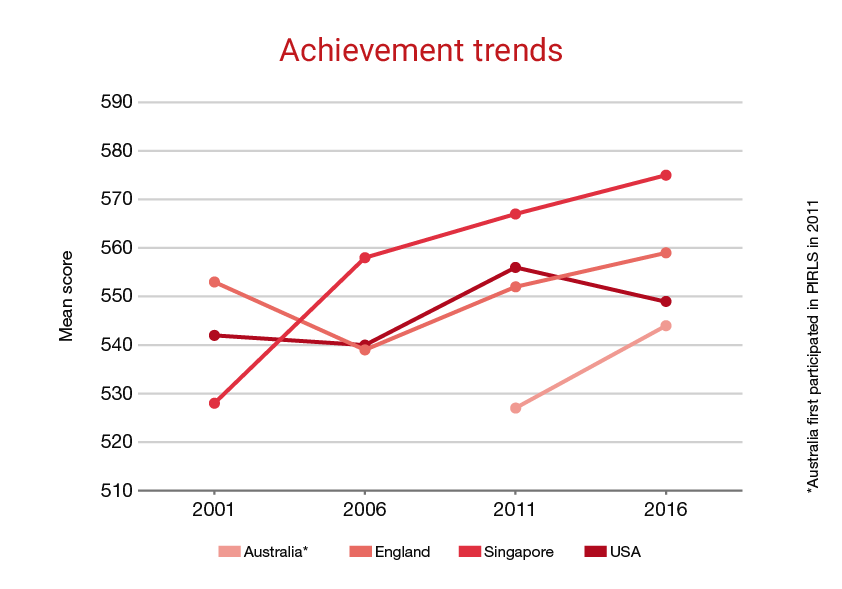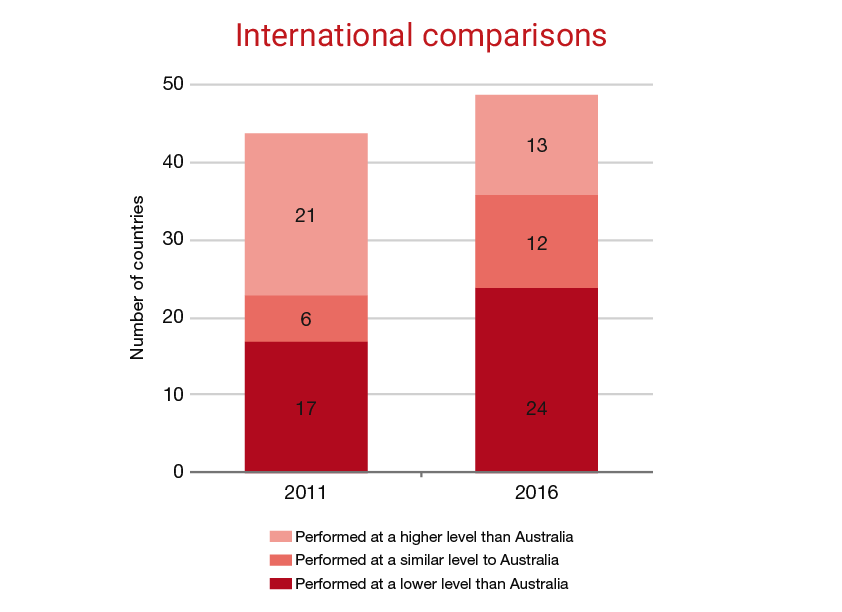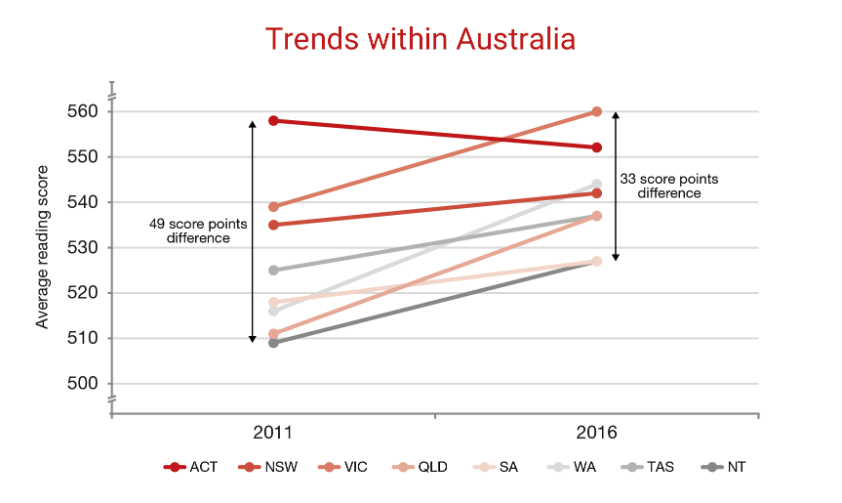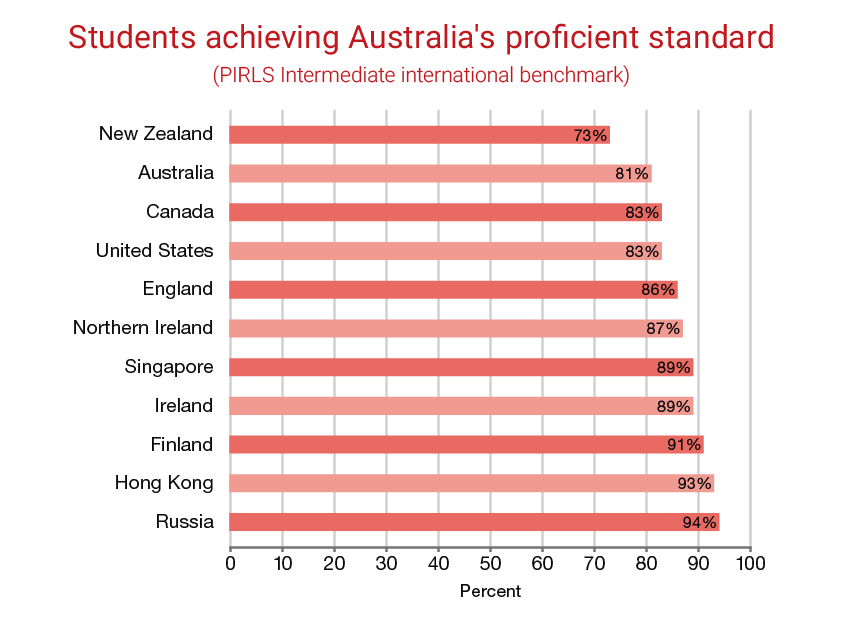
Children’s reading literacy achievement: PIRLS 2016
Research 5 Dec 2017 7 minute readResults from an international study of Year 4 students' reading literacy indicate positive changes in Australia’s achievement.
Children’s reading literacy achievement: PIRLS 2016
- Australia one of 18 countries to improve average reading score since 2011
- 81 per cent of Australian Year 4 students met or exceeded the national proficient standard
- Achievement gap between metropolitan and remote school students has narrowed
Australian Year 4 students have significantly improved their reading achievement, according to the latest Progress in International Reading Literacy Study (PIRLS). The Australian Council for Educational Research (ACER) released the national report, titled PIRLS 2016: Reporting Australia's results, in December 2017.
PIRLS has measured trends in Year 4 students’ reading literacy achievement every five years since 2001. It is a project of the International Association for the Evaluation of Educational Achievement (IEA) and is directed by the PIRLS International Study Center at Boston College. ACER manages the implementation and reporting of PIRLS within Australia, with funding from the Australian, and state and territory governments.
In 2016, PIRLS measured the reading literacy of more than 580 000 Year 4 students from 50 participating countries and 11 benchmarking entities, including a nationally representative sample of 6341 Australian students from 286 primary schools. 2016 is the second time Australia has taken part in PIRLS, following participation in 2011.
Australian average score improves
Australia was one of 18 countries to record a significant improvement in average reading score between PIRLS 2011 and 2016, while a further 13 countries recorded similar achievement in both cycles and 10 showed declines. Australia's average reading score increased from 527 points in 2011 to 544 points in 2016.
Figure 1: Achievement trends in PIRLS, selected countries
Australia’s 2016 average reading score was lower than the average scores for 13 other countries, including Singapore, Hong Kong, Ireland, Northern Ireland and England (which all tested in English), as well as other top-performing countries the Russian Federation, Finland and Poland. This was an improvement on 2011, when Australia’s average score was lower than the average scores for 20 other countries.
Figure 2: Performance of countries in PIRLS 2016 in relation to Australia
In addition to the improvement in Australia’s overall reading score, PIRLS 2016 also saw an improvement in the differences between its states and territories. The gap between the average scores of Australia’s highest and lowest performing jurisdictions reduced from 49 points in 2011 to 33 points in 2016. Western Australia, Queensland and Victoria showed a significant improvement in average reading literacy achievement between PIRLS 2011 and 2016, while the changes in the remaining states and territories did not reach statistical significance.
Figure 3: Achievement trends in PIRLS, by Australian jurisdiction
National proficient standard
Australia’s Measurement Framework for Schooling identifies the Intermediate international benchmark in PIRLS as the nationally agreed proficient literacy standard for Australia, as it ‘represents a “challenging but reasonable” expectation of student achievement at a year level with students needing to demonstrate more than elementary skills expected at that year level’.
PIRLS 2016 shows that 81 per cent of Australian Year 4 students are achieving at or above the Intermediate benchmark, compared to 76 per cent in 2011, with more students achieving at the High or Advanced benchmark. However, in top performing countries the Russian Federation, Hong Kong and Finland, more than 90 per cent of students achieved at or above the Intermediate benchmark in 2016.
Figure 4: Percentage of students at or above Intermediate benchmark, selected countries
One in five Australian students (20 per cent) failed to reach the Intermediate benchmark in PIRLS 2016, compared to around one in four students (24 per cent) in 2011. The proportion of Australian students not reaching the Low benchmark remained unchanged at around six per cent. At the other end of the scale, 16 per cent of Australian students achieved the Advanced benchmark in 2016, compared to 29 per cent in Singapore and 26 per cent in the Russian Federation.
Achievement gaps
In 2016, the range of achievement separating the scores of Australia’s highest and lowest achievers was 274 points. Compared to other countries, this level of diversity in student achievement was considered mid-range, and was similar to that of high performing countries Northern Ireland (267 points) and Singapore (263 points). The smallest achievement gap was found in the Netherlands (198 points), while the largest achievement gap was found in Egypt (408 points).
While PIRLS 2016 indicates improvement in Australian students’ average reading performance since 2011, it also highlights the existence of groups of students for whom reading comprehension remains an area of great difficulty.
Gender
Australia was one of 48 countries to record significant differences in achievement favouring girls. The gender gap in reading performance in Year 4 students in Australia has remained the same between 2011 and 2016, with both boys and girls improving at about the same rate over the two cycles.
In 2016, 85 per cent of Australia's girls met or exceeded the national proficient standard, compared to 77 per cent of boys. Further analysis revealed that Australia’s Year 4 boys had twice the odds of being a poor reader compared to Year 4 girls.
Indigenous status
Australia’s Aboriginal and Torres Strait Islander students attained an average score of 483 points, which was 67 points lower than the average score for non-Indigenous students. While the average score for Australian students increased between PIRLS 2011 and 2016, the average score for students with an Aboriginal or Torres Strait Islander background did not change significantly over the same period.
In 2016, 57 per cent of Aboriginal and Torres Strait Islander students met or exceeded the national proficient standard, compared to 83 per cent of non-Indigenous students. Students with an Aboriginal or Torres Strait Islander background had almost four times the odds of being a poor reader compared to non-Indigenous students.
Socioeconomic background
In PIRLS, the number of books in the home is used as a proxy for student-level socioeconomic status. On average, students who reported having many books (>200) in the home scored 22 points higher than students with an average number of books (26–200) in the home, and 80 points higher than those with a few books (<26) in the home.
In 2016, 89 per cent of Australian students who reported having many books in the home met or exceeded the national proficient standard, compared to 86 per cent for students having an average number of books and 65 per cent for those with a few books. Students who reported having only a few books at home had more than three times the odds of being a poor reader compared to students with more books in the home.
In terms of school-level socioeconomic background, 89 per cent of students attending more affluent schools met or exceeded the national proficient standard, compared to 81 per cent of students in neither more affluent nor more disadvantaged schools and 69 per cent of students in more disadvantaged schools. Students who attended schools that were categorised by their principals as more disadvantaged had more than twice the odds of being a poor reader compared to students in other schools.
School location
The achievement gap between Australian students attending metropolitan and remote schools has narrowed from 70 points in 2011 to 21 points in 2016. Most of this narrowing is a result of substantial improvement in the achievement of students from remote schools, for whom the proportion meeting or exceeding the national proficient standard was just 48 per cent in 2011.
In 2016, 70 per cent of students from remote schools met or exceeded the national proficient standard, as did 77 per cent of students from provincial schools and 82 per cent of students from metropolitan schools. Nevertheless, students who attended a remote school had almost three times the odds of being a poor reader compared to students in other schools.
Encouragingly, in 2016 there were no significant differences in the proportions of metropolitan, provincial and remote students reaching the Advanced benchmark, at 16, 14 and 12 per cent respectively. This, too, represents a narrowing of the achievement gap since 2011, when just one per cent of remote students reached the Advanced benchmark compared to 11 per cent of metropolitan students.
Read the full report:
PIRLS 2016: Reporting Australia’s results, by Sue Thomson, Kylie Hillman, Marina Schmid, Sima Rodrigues and Jessica Fullarton, ACER (2017).



